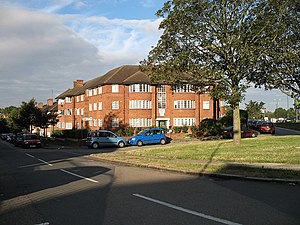Urban dwellers must face the reality that cities are becoming increasingly over-crowded which means that housing is in short supply.
In New York City, 1.8 million one- and two-person households exist, but there are only 1 million studio and one-bedroom apartments in Manhattan, leaving a housing shortage.
The surge of tech wizards descending on San Francisco and the Bay area has caused rent in the city to skyrocket 22 percent since 2008, according to The New York Times.
London, too, is dealing with a housing crisis, where 1 in 10 people are on housing waiting lists, according to The Guardian.
| (Photo credit: Wikipedia) |
Clearly there is an urban housing crisis happening around the world, and it's forcing cities to rethink their approaches to real estate. But there's a solution: micro-apartments.
A global trend
New York City's housing shortage prompted Mayor Michael Bloomberg's administration to commission 80 300-square-foot apartments in Manhattan this past summer. These prospective apartments, which are expected to rent for $2,000 a month, are so small that Bloomberg will have to amend zoning laws, which currently states that all apartments must be at least 400 square feet. The apartments in New York City will be just four times the size of a standard prison cell.
"People from all over the world want to live in New York City, and we must develop a new, scalable housing model that is safe, affordable and innovative to meet their needs," Bloomberg said in a statement announcing the apartments.
San Francisco has an influx of aspiring tech workers, but not nearly enough units to accommodate them. So the city is considering legislation that would change the city's building codes to allow developers to build micro-apartments as small as 220 square feet--even smaller than New York's. The legislation will be voted on in November.
“We have a housing affordability crisis here; rents are through the roof,” Scott Wiener, the city supervisor who introduced the legislation for the micro apartments in San Francisco, told The New York Times.
The city of San Jose, California, has already built 220-square-foot micro-units, while other cities across the country, like Seattle, Chicago and Boston are also considering the idea, according to the New York Times.
Similarly, several international cities like London, Warsaw, and cities in China have all adopted a micro-apartment model, where residents pay high prices to live in tiny, but optimally-located, living spaces.
An 8' X 10' apartment in London was originally on sale for $145,000, but because of its prime location, next to Harrod's department store, more than 12 bids have been put on the apartment. The real estate agent selling the property guessed the place will sell closer to $500,000.
The city of Dongguan, in southeast China, is considering building apartments that measure a mere 160 square feet--about the size of a parking space, according to the Wall Street Journal. These tiny apartments would provide an affordable solution to the city's housing crisis.
In Warsaw, Poland, micro-apartments are more of an art form and an experiment. A five-foot-wide "home" opened last week, where artist Etgar Keret plans to live for six months, and then eventually rent out. The bathroom is so small in the home that the shower head hovers above the toilet.
Paris, Tokyo and Singapore are also known for having tiny apartments.
An ongoing debate
But not everyone believes that these micro-apartments are the solution. Tenants rights advocates worry that this trend could set a bad precedent.
“Are we saying it is acceptable to box people up in little tiny spaces?” Tommi Avicolli Mecca, director of counseling at the Housing Rights Committee, a nonprofit organization, told the New York Times. “What standard are we setting here?”
These tiny apartments could also create a larger issue that divides classes. Will these new micro-units mean that only the super rich can afford to live in 800-square-foot plus apartments while the middle class settles for 300-square-foot closets?
Designing for micro-apartments
Some entrepreneurs are embracing the trend and finding ways to help people maximize their space. In order to live in these tiny apartments, the space has to be utilized cleverly.
Simon Woodroffe, founder of Yotel, has created a transforming apartment, with walls that move to create new spaces, or to allow a kitchen table to pop up from the floor.
"History will judge us for living in an absolutely primitive age compared to what it's going to be compared with the future of these types of home. People are going to say 'remember when they only had one space and it couldn't move around?'" Woodroffe said in an interview with CNN Money.
Other companies such as the Itzy Bitzy furniture store, have created smaller versions of end tables, dressers, and head boards, so inhabitants of these tiny apartments can still feel as if their home is furnished properly. Similarly, CB2, an extension company from Crate & Barrel, makes modern furniture for apartments and lofts. The furniture is to scale with smaller living spaces, but gives consumers trendy options. Companies such as West Elm, Milano Smart Living, and even super store IKEA have all surged on the small living trend.
It's clear that cities across the world see the only solution to the housing crisis is to think small.
By Meredith Galante
Taken from: http://www.businessinsider.com/micro-apartment-trend-2012-10






No comments:
Post a Comment